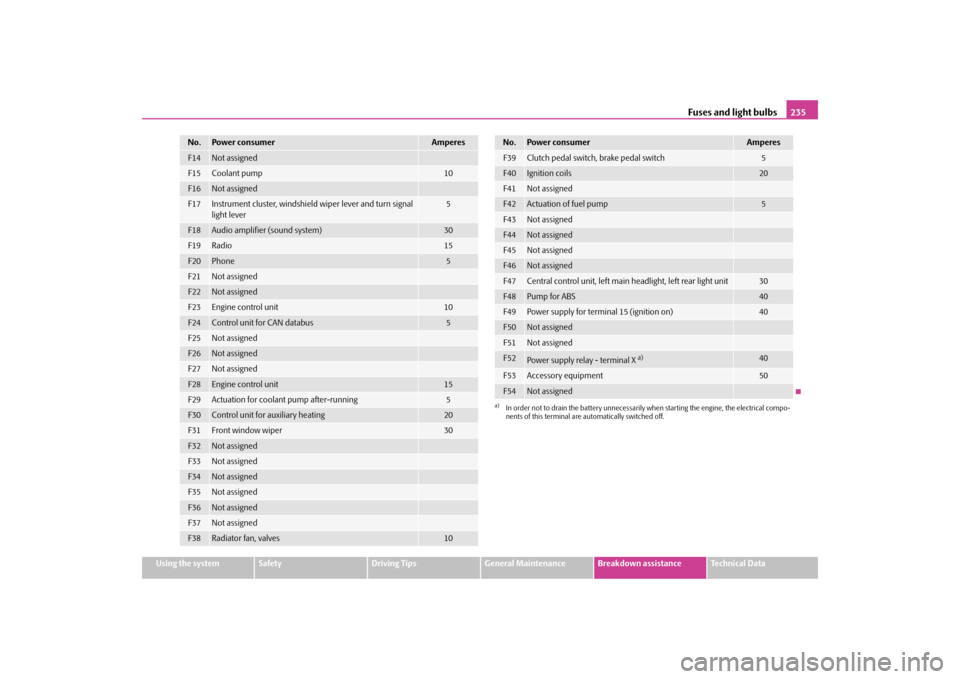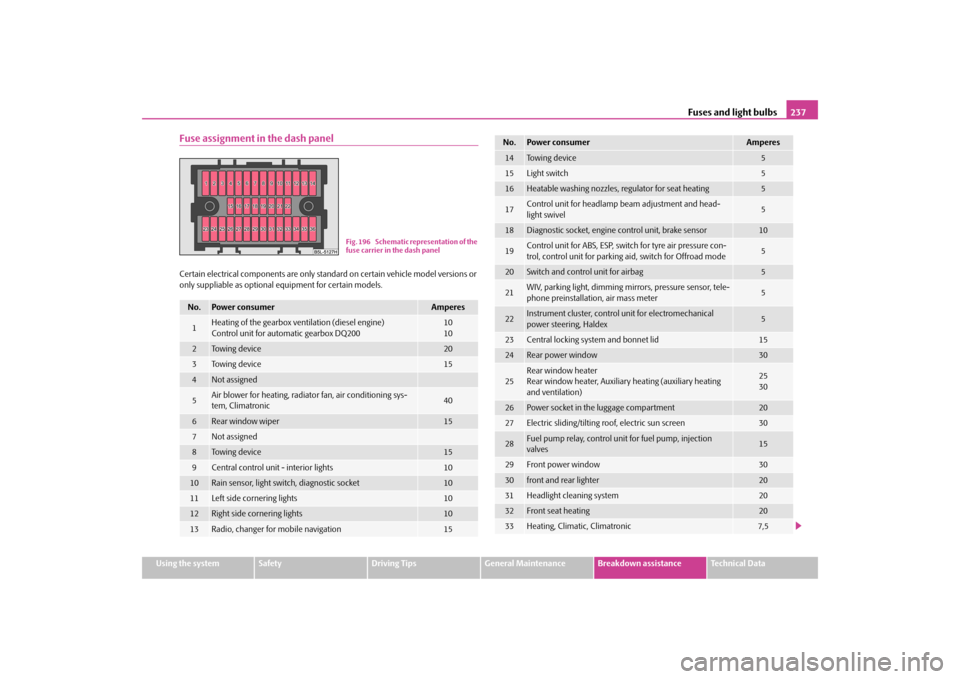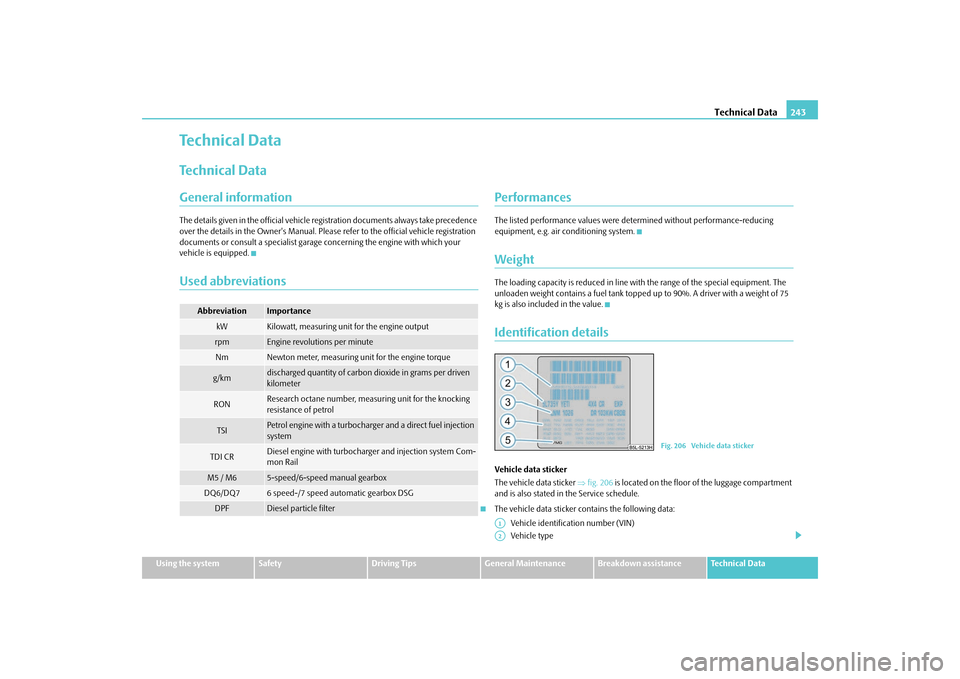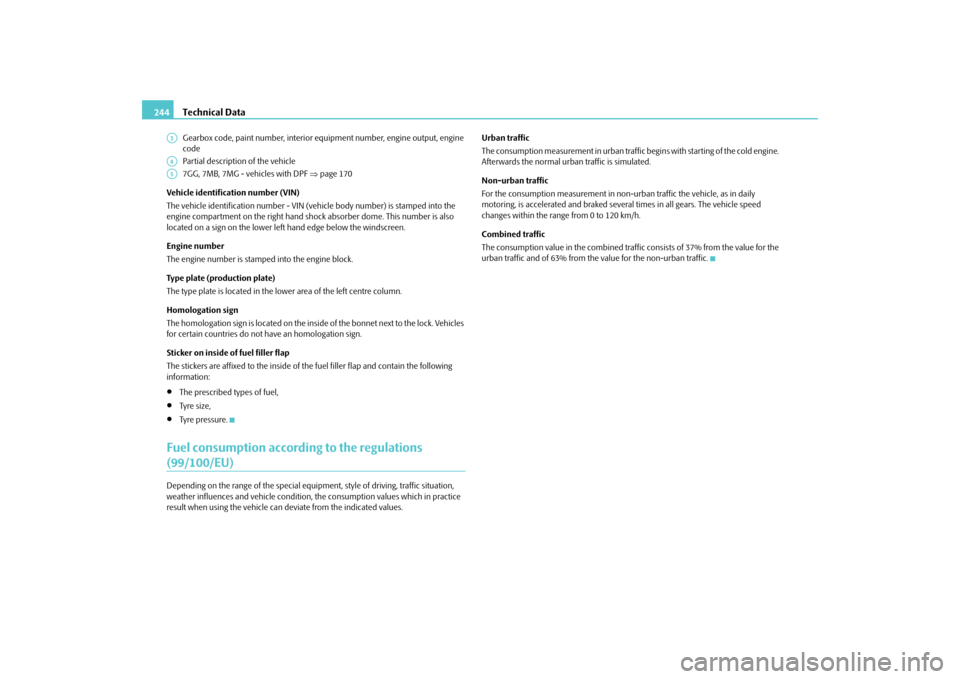technical data SKODA YETI 2009 1.G / 5L Owner's Manual
[x] Cancel search | Manufacturer: SKODA, Model Year: 2009, Model line: YETI, Model: SKODA YETI 2009 1.G / 5LPages: 271, PDF Size: 16.24 MB
Page 234 of 271

Fuses and light bulbs
233
Using the system
Safety
Driving Tips
General Maintenance
Breakdown assistance
Technical Data
Fuses and light bulbsElectric fusesReplacing fuses Defect fuses must be replaced.Individual electrical circuits are protected by
fuses. The fuses are located on the left
side of the dash panel behind the safety
cover and under the cover in the engine
compartment on the left. – Switch the ignition off and also the electrical component affected. – Insert the wrench into the opening on the bottom side of the dash panel
⇒fig. 192
and remove the side cover or the cover in the engine compartment
⇒page 234.
– Find out which fuse belongs to the relevant component
⇒page 237, “Fuse assign-
ment in the dash panel”,
⇒page 234, “Fuse assignment in engine compartment -
version 1” or
⇒page 236, “Fuse assignment in engine compartment - version 2”.
– Take the plastic clip out of it
s fixture in the fuse cover, insert it onto the respective
fuse and pull out this fuse.
– Defect fuses can be detected by their melted metal strips. Replace the defect fuse
by a new fuse of the
same
ampere number.
– Fit on the fuse cover again.
We recommend that you always have the
small box of replacement fuses in your
vehicle. You can obtain repl
acement fuses from Škoda original accessories or from a
specialist garage
17).
Colour coding of fuses
Caution
•
Never attempt to “repair” fuses and also do
not replace them with a fuse of a higher
amperage - risk of fire! This may also caus
e damage at another part of the electrical
system.•
Have the electrical system checked as quickly as possible by a specialist garage if a
newly inserted fuse blows again after a short time.
Fig. 192 Fuse cover: left side of the dash panel
17)The small box with replacement fuses is part of
the basic equipping of th
e vehicle in some coun-
tries.
Colour
Maximum amperage
light brown
5
brown
7,5
red
10
blue
15
yellow
20
white
25
green
30
orange
40
red
50
sgg.6.book Page 233 Thursday, September 24, 2009 2:32 PM
Page 236 of 271

Fuses and light bulbs
235
Using the system
Safety
Driving Tips
General Maintenance
Breakdown assistance
Technical Data
F14
Not assigned
F15
Coolant pump
10
F16
Not assigned
F17
Instrument cluster, windshield
wiper lever and turn signal
light lever
5
F18
Audio amplifier (sound system)
30
F19
Radio
15
F20
Phone
5
F21
Not assigned
F22
Not assigned
F23
Engine control unit
10
F24
Control unit for CAN databus
5
F25
Not assigned
F26
Not assigned
F27
Not assigned
F28
Engine control unit
15
F29
Actuation for coolant pump after-running
5
F30
Control unit for auxiliary heating
20
F31
Front window wiper
30
F32
Not assigned
F33
Not assigned
F34
Not assigned
F35
Not assigned
F36
Not assigned
F37
Not assigned
F38
Radiator fan, valves
10
No.
Power consumer
Amperes
F39
Clutch pedal switch, brake pedal switch
5
F40
Ignition coils
20
F41
Not assigned
F42
Actuation of fuel pump
5
F43
Not assigned
F44
Not assigned
F45
Not assigned
F46
Not assigned
F47
Central control unit, left main headlight, left rear light unit
30
F48
Pump for ABS
40
F49
Power supply for terminal 15 (ignition on)
40
F50
Not assigned
F51
Not assigned
F52
Power supply relay - terminal X
a)
40
F53
Accessory equipment
50
F54
Not assigned
a)In order not to drain the battery unnecessarily wh
en starting the engine
, the electrical compo-
nents of this terminal are automatically switched off.No.
Power consumer
Amperes
sgg.6.book Page 235 Thursday, September 24, 2009 2:32 PM
Page 238 of 271

Fuses and light bulbs
237
Using the system
Safety
Driving Tips
General Maintenance
Breakdown assistance
Technical Data
Fuse assignment in the dash panelCertain electrical components are only standard on certain vehicle model versions or only suppliable as optional
equipment for certain models.
No.
Power consumer
Amperes
1
Heating of the gearbox ve
ntilation (diesel engine)
Control unit for automatic gearbox DQ200
1010
2
To w i n g d e v i c e
20
3
To w i n g d e v i c e
15
4
Not assigned
5
Air blower for heating, radiat
or fan, air conditioning sys-
tem, Climatronic
40
6
Rear window wiper
15
7
Not assigned
8
To w i n g d e v i c e
15
9
Central control unit - interior lights
10
10
Rain sensor, light switch, diagnostic socket
10
11
Left side cornering lights
10
12
Right side cornering lights
10
13
Radio, changer for mobile navigation
15
Fig. 196 Schematic representation of the fuse carrier in the dash panel
14
To w i n g d e v i c e
5
15
Light switch
5
16
Heatable washing nozzles, regulator for seat heating
5
17
Control unit for headlamp be
am adjustment and head-
light swivel
5
18
Diagnostic socket, engine
control unit, brake sensor
10
19
Control unit for ABS, ESP, swit
ch for tyre air pressure con-
trol, control unit for parking aid, switch for Offroad mode
5
20
Switch and control unit for airbag
5
21
WIV, parking light, dimming mirrors, pressure sensor, tele- phone preinstallation, air mass meter
5
22
Instrument cluster, control
unit for electromechanical
power steering, Haldex
5
23
Central locking system and bonnet lid
15
24
Rear power window
30
25
Rear wind
ow heater
Rear window he
ater, Auxiliary heating (auxiliary heating
and ventilation)
25 30
26
Power socket in the luggage compartment
20
27
Electric sliding/tilting roof, electric sun screen
30
28
Fuel pump relay, control unit for fuel pump, injection valves
15
29
Front power window
30
30
front and rear lighter
20
31
Headlight cleaning system
20
32
Front seat heating
20
33
Heating, Climatic, Climatronic
7,5
No.
Power consumer
Amperes
sgg.6.book Page 237 Thursday, September 24, 2009 2:32 PM
Page 240 of 271

Fuses and light bulbs
239
Using the system
Safety
Driving Tips
General Maintenance
Breakdown assistance
Technical Data
WARNING
•
Bulbs H7 and H4 are pressurised and
may burst when changing the bulb -
risk of injury!•
It is recommended to wear gloves and
safety glasses when changing a bulb.
•
Gas discharge bulbs* (xenon bulbs) op
erate with a high voltage, profes-
sional knowledge is required - danger to life!
Caution
Do not take hold of the glass bulb with naked fingers (even the smallest amount of dirt reduces the working life of the light bulb).
Use a clean cloth, serviette or something
similar.
Note
This Owner's Manual only describes the replacement of bulbs where it is assumed that no major complications will
arise. Other light bulbs should be replaced by your
specialist garage.
Front headlightPositions of the light bulbs in the front headlight
⇒fig. 197
.
- Fog lights and daylight driving lights - Parking lights (Xenon headlight) - Parking lights (halogen headlight), low beam lights and main beam lightsTurn signal light at the frontYou should have the light bulb of the front
turn signal light replaced by a specialist
garage.Parking light at the frontFig. 198 Remove cap / removing the fixtur
e for the parking light (halogen headlight)
Luggage compartment light
W5W
Door warning light
W5W
Lighting in storage compartment on front passenger side
C3W
Others
Bulb
Fig. 197 Front headlight: Fitting position of the bulbs
AAABAC
sgg.6.book Page 239 Thursday, September 24, 2009 2:32 PM
Page 242 of 271

Fuses and light bulbs
241
Using the system
Safety
Driving Tips
General Maintenance
Breakdown assistance
Technical Data
Removing the bulb for the fog light– Switch the ignition and all lights off. – Remove the rubber protective cap
⇒page 239, fig. 197
.
– Unplug plug . – Take the faulty bulb out of the fixture
by pressing the li
ght socket downwards
and insert a new one.
– Insert the protective cap.Daylight driving lightsRemove the bulb for daylight driving lights– Switch the ignition and all lights off. – Remove the rubber protective cap
⇒page 239, fig. 197
.
– Unplug plug .– Take the faulty bulb out of the fixture by turning in direction of arrow and insert
a new one in the reverse procedure.
– Insert the protective cap.
Rear light unitFig. 203 Removing the rear light unit
/ disconnecting the plug connection
– Open the boot lid. – Unscrew the light with the aid of the Torx
wrench from the vehicle tool kit. The
shorter side of the wrench is used for loosening the screws and the longer side for screwing the screws out completely
⇒fig. 203
.
– Grasp the light at the top and bottom part and pull it slightly to the rear.– Disconnect the plug connection by pressing the catches in direction of arrow
and by pulling them in direction of arrow
⇒fig. 203
.
Changing light bulbs in the rear light unitFig. 204 Remove the middle part
of the light / rear light unit:
Fitting position of the bulbs
AA
A1
A2
Fig. 202 Remove the bulb for daylight driving lights
AA
A1
A2
A1
A2
A3
sgg.6.book Page 241 Thursday, September 24, 2009 2:32 PM
Page 244 of 271

Technical Data
243
Using the system
Safety
Driving Tips
General Maintenance
Breakdown assistance
Technical Data
Te c h n i c a l D a t aTechnical DataGeneral informationThe details given in the official vehicle regi
stration documents always take precedence
over the details in the Owner's Manual. Please refer to the official vehicle registration documents or consult a specialist garage
concerning the engine with which your
vehicle is equipped.Used abbreviations
PerformancesThe listed performance values were de
termined without performance-reducing
equipment, e.g. air
conditioning system.
WeightThe loading capacity is reduced in line with the range of the special equipment. The unloaden weight contains a fuel tank topped
up to 90%. A driver with a weight of 75
kg is also includ
ed in the value.
Identification detailsVehicle data sticker The vehicle data sticker
⇒fig. 206
is located on the floor of the luggage compartment
and is also stated in the Service schedule. The vehicle data sticker co
ntains the following data:
Vehicle identification number (VIN) Vehicle type
Abbreviation
Importance
kW
Kilowatt, measuring unit for the engine output
rpm
Engine revolutions per minute
Nm
Newton meter, measuring
unit for the engine torque
g/km
discharged quantity of carbon dioxide in grams per driven kilometer
RON
Research octane number, meas
uring unit for the knocking
resistance of petrol
TSI
Petrol engine with a turbocharger and a direct fuel injection system
TDI CR
Diesel engine with turbocharger and injection system Com- mon Rail
M5 / M6
5-speed/6-speed manual gearbox
DQ6/DQ7
6 speed-/7 speed automatic gearbox DSG
DPF
Diesel particle filter
Fig. 206 Vehicle data sticker
A1A2
sgg.6.book Page 243 Thursday, September 24, 2009 2:32 PM
Page 245 of 271

Technical Data
244
Gearbox code, paint number, interior eq
uipment number, engine output, engine
code Partial description of the vehicle 7GG, 7MB, 7MG - vehicles with DPF
⇒page 170
Vehicle identification number (VIN) The vehicle identification number - VIN (veh
icle body number) is stamped into the
engine compartment on the right hand sh
ock absorber dome. This number is also
located on a sign on the lower left hand edge below the windscreen. Engine number The engine number is stam
ped into the engine block.
Type plate (production plate) The type plate is located in the lowe
r area of the left centre column.
Homologation sign The homologation sign is located on the insi
de of the bonnet next to the lock. Vehicles
for certain countries do not
have an homologation sign.
Sticker on inside of fuel filler flap The stickers are affixed to the inside of the fuel filler flap and contain the following information:•
The prescribed types of fuel,
•
Ty re s i z e ,
•
Tyre pressure.
Fuel consumption according to the regulations (99/100/EU)Depending on the range of the special equipment, style of driving, traffic situation, weather influences and vehicl
e condition, the consumption
values which in practice
result when using the vehicle can deviate from the indicated values.
Urban traffic The consumption measurement in urban traffic
begins with starting of the cold engine.
Afterwards the normal urban traffic is simulated. Non-urban traffic For the consumption measurement in non-ur
ban traffic the vehicle, as in daily
motoring, is accelerated and braked severa
l times in all gears. The vehicle speed
changes within the range from 0 to 120 km/h. Combined traffic The consumption value in the combined traffic consists of 37% from the value for the urban traffic and of 63% from th
e value for the non-urban traffic.
A3A4A5sgg.6.book Page 244 Thursday, September 24, 2009 2:32 PM
Page 246 of 271

Technical Data
245
Using the system
Safety
Driving Tips
General Maintenance
Breakdown assistance
Technical Data
DimensionsDimensions (mm)Other informationAngle (in degree)Length
4223
Width
1793
Width including exterior mirror
1956
Height
1691
Clearance
180
Wheel base
2578
Track gauge front / rear
1541/1537
Front embankment angle
19
Rear embankment angle
26,7
Ramp angle
19,4
Slope angle (°)/ climbing ability (%)
1.2 ltr./77 kW TSI - M6
24/45
1.8 ltr./118 kW TSI - M6 4x4
29/55
2.0 ltr./81 kW TDI CR - M5
29/55
2.0 ltr./81 kW TDI CR - M6 4x4
31/60
2.0 ltr./103 kW TDI CR - M6 4x4
31/60
2.0 ltr./125 kW TDI CR - M6 4x4
31/60
sgg.6.book Page 245 Thursday, September 24, 2009 2:32 PM
Page 247 of 271

Technical Data
246
Engine oil specificationsThe grade of engine oil should be se
lected in accordance with precise
specifications.The engine of your vehicle has been factory-
filled with a high-grade oil which you can
use throughout the year - except in extreme climatic regions. You can mix various oils together with each other when refilling with oil. This does not, however, apply for models with flexible service intervals (QG1). Engine oils are, of course, undergoing co
ntinuous further deve
lopment. Thus the
information stated in this Owner's Manual is
only correct at the time of publication.
Specialist garages are informed by Škoda
Auto about current changes. We recommend
having this oil change undertaken by a specialist garage. The specifications (VW standards) stated in the following must be indicated separately or together with other specifications on the bottle. Engine oil specifications for models
with flexible service intervals (QG1)
Engine oil specifications for vehicles with fixed service intervals (QG2)
If the oils specified above are not available, oils according to ACEA A2 or ACEA A3 can be used once for refilling. If the oils specified above are not available,
oils according to ACEA B3 or ACEA B4 can
be used once for refilling.
Caution
Only the above-mentioned oils may be used on vehicles with flexible service intervals (QG1). We recommend always refilling with oi
l of the same specification since this will
maintain the properties of the oil. In exce
ptional cases, you must top up only once
engine oil complying with Specification VW 50
2 00 (only for petrol engines) or Specifi-
cation VW 505 01 (only for diesel engines) to maximum 0.5 litres. You must not use other engine oils - risk of engine damage!
Note
•
Before a long drive we recommend that
you purchase and carry with you engine
oil which complies with the specification for your vehicle. Consequently, you will always have the correct engine oil for refilling.•
We recommend using a preservative from the Škoda original accessories offered
by your Škoda dealer.•
For further information - see Service shedule.
Petrol engines
Engine oil specifications
1.2 ltr./77 kW TSI - EU5
VW 504 00
1.8 ltr./118 (112) kW TSI - EU5
VW 504 00
Diesel engines
Engine oil specifications
2.0 ltr./81 kW TDI CR DPF - EU5
VW 507 00
2.0 ltr./103 kW TDI CR DPF - EU5
VW 507 00
2.0 ltr./125 kW TDI CR DPF - EU5
VW 507 00
Petrol engines
Engine oil specifications
1.2 ltr./77 kW TSI - EU5
VW 502 00
1.8 ltr./118 kW TSI - EU5
VW 502 00
Diesel engines
Engine oil specifications
2.0 ltr./81 kW TDI CR DPF - EU5
VW 507 00
2.0 ltr./103 kW TDI CR DPF - EU5
VW 507 00
2.0 ltr./125 kW TDI CR DPF - EU5
VW 507 00
sgg.6.book Page 246 Thursday, September 24, 2009 2:32 PM
Page 248 of 271

Technical Data
247
Using the system
Safety
Driving Tips
General Maintenance
Breakdown assistance
Technical Data
1.2 ltr./77 kW TSI - EU°5Engine Performances Fuel consumption (in ltr./100 km) and CO
2 emission (in g/km)
Power output
kW per rpm
77/5000
Maximum torque
Nm per rpm
175/1500-3500
Number of cylinders/Displacement (cm
3)
4/1197
Fuel - unleaded petrol min. RON
95M6
Maximum speed
km/h
175
Acceleration 0 - 100 km/h
s
11,8M6
Urban
7,6a)/7,9
b)
a)Unloaden weight with special equipment up to 1505 kg.b)Unloaden weight with special equipment more than 1505 kg.Non-urban
5,9a)/5,9
b)
Combination
6,4a)/6,6
b)
CO2 emission - combination
149
a)/154
b)
sgg.6.book Page 247 Thursday, September 24, 2009 2:32 PM